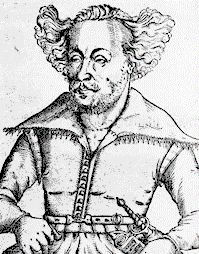Johann Hermann Schein facts for kids
Quick facts for kids
Johann Hermann Schein
|
|
|---|---|
 |
|
| Born | January 20, 1586 Grünhain
|
| Died | 19 November 1630 (aged 44) |
| Education | University of Leipzig |
| Occupation | Thomaskantor |
Johann Hermann Schein (born January 20, 1586 – died November 19, 1630) was a talented German composer from the early Baroque period. He was a very important musician in Leipzig, working as the Thomaskantor from 1615 until he passed away in 1630. Schein was one of the first composers to bring exciting new Italian music styles into German music. He was known for creating beautiful and polished musical pieces.
Contents
A Young Musician's Life
Johann Hermann Schein was born in a town called Grünhain. When his father died, he moved to Dresden. There, he joined the choir of the Elector of Saxony as a boy soprano. This was a great opportunity! Besides singing, he received excellent musical training from Rogier Michael, who was the Kapellmeister (music director). Michael quickly saw how talented young Johann was.
From 1603 to 1607, Schein studied at a school called Pforta. Then, from 1608 to 1612, he attended the University of Leipzig. At the university, he studied law, but he also continued his studies in liberal arts, which included music.
After finishing his studies, he worked briefly for a man named Gottfried von Wolffersdorff. He was the music director for the household and taught Wolffersdorff's children. Later, Schein became the Kapellmeister in Weimar. Soon after that, he got the important job of Thomaskantor in Leipzig. This meant he was the music director, especially at the Thomasschule zu Leipzig, and he led the famous Thomanerchor choir. He held this important position for the rest of his life.
Sadly, Johann Hermann Schein had many health problems throughout his life. He died in Leipzig when he was only 44 years old.
Schein's Musical Style
Schein was one of the first composers in Germany to really understand and use the new musical ideas coming from Italy during the Baroque period. These new ideas included:
- Monody: A style where one singer takes the lead with instrumental music playing along.
- Concertato style: Music that uses different groups of instruments or voices that play together or answer each other.
- Figured bass: A kind of musical shorthand for keyboard players to create harmonies.
Even though Schein never traveled to Italy, he understood these Italian styles very well and used them in his German Lutheran church music. His early music in the concertato style was likely inspired by an Italian collection called Cento concerti ecclesiastici by Lodovico Grossi da Viadana.
Unlike his friend Heinrich Schütz, who mostly wrote sacred (religious) music, Schein wrote both sacred and secular (non-religious) music. He wrote about the same amount of each, and almost all of it was for voices. For his secular vocal music, he even wrote all of his own lyrics!
Throughout his life, he published collections of sacred and secular music one after the other. He wanted to create music for both church services and social gatherings. The two types of music could be very different. Some of his sacred music used complex techniques, like those found in Italian madrigals, for worship. An example is his motet Wie lieblich sind deine Wohnungen, which uses words from Psalm 84.
On the other hand, some of his secular collections included fun and simple drinking songs! Some of his works are incredibly expressive, like Fontana d'Israel (also known as Israel's Brünnlein) from 1623. In this work, Schein wanted to explore all the ways to use German word-painting (making the music sound like the words) in the style of Italian madrigals.
Perhaps his most famous collection was his only collection of instrumental music, called Banchetto musicale (which means Musical banquet). This collection from 1617 has twenty different suites that use variations. These are some of the earliest and best examples of this musical form. They were probably written as dinner music for royal courts and were meant to be played on viols (instruments similar to violins). Each suite in the Banchetto musicale includes different dances: a pavan and galliard (a common pair from that time), a courante, and then an allemande and tripla.
Published Works
Here are some of the musical works Johann Hermann Schein published:
Sacred Vocal Music
- Cymbalum Sionium (1615)
- Opella nova, geistlicher Concerten (1618)
- Fontana d'Israel, Israelis Brünnlein (1623)
- Opella nova, ander Theil, geistlicher Concerten (1626)
- Cantional oder Gesangbuch Augspurgischer Confession (1627, 1645)
Secular Vocal Music
- Venus Kräntzlein (1609)
- Musica boscareccia (1621, and parts published later)
- Studenten-Schmauss (1626)
- So da, mein liebes Brüderlein (1626)
Instrumental Music
- Banchetto musicale (1617)
See also
 In Spanish: Johann Hermann Schein para niños
In Spanish: Johann Hermann Schein para niños

